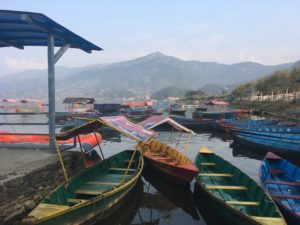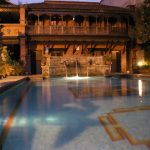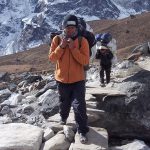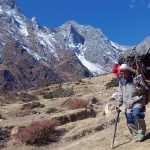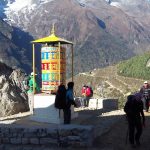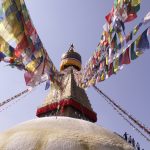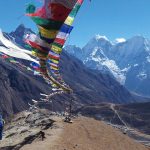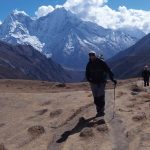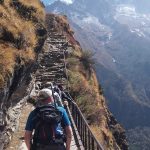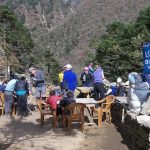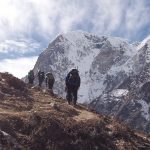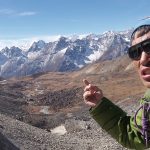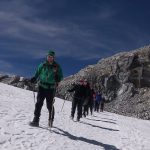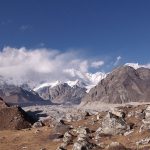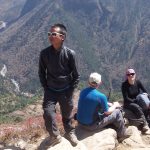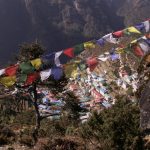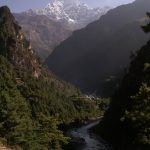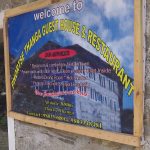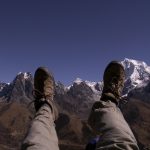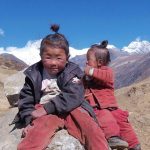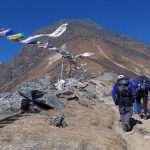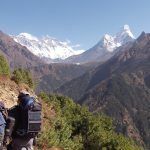Everest Base Camp Via the Serene and Inspirational Gokyo Valley
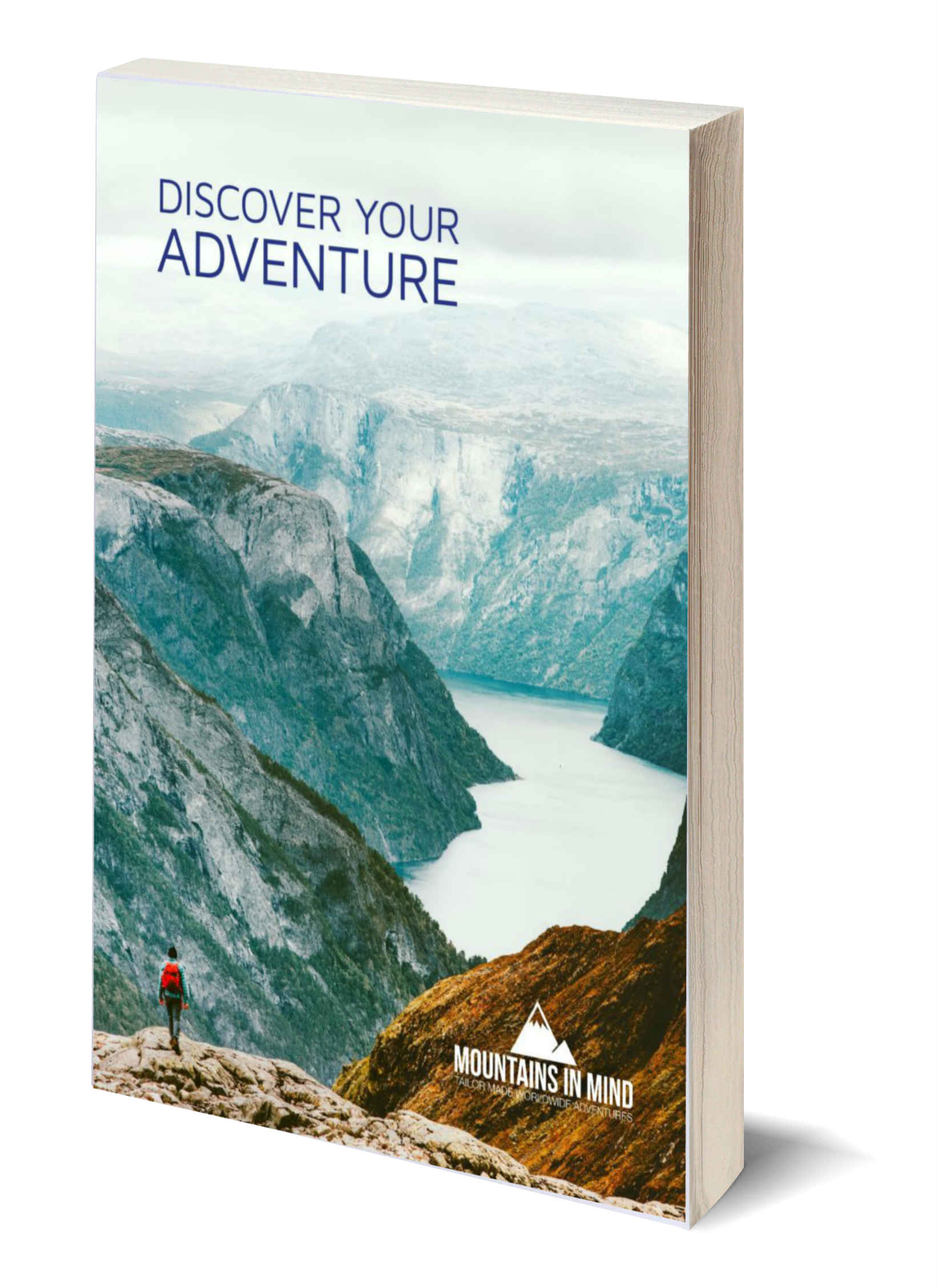
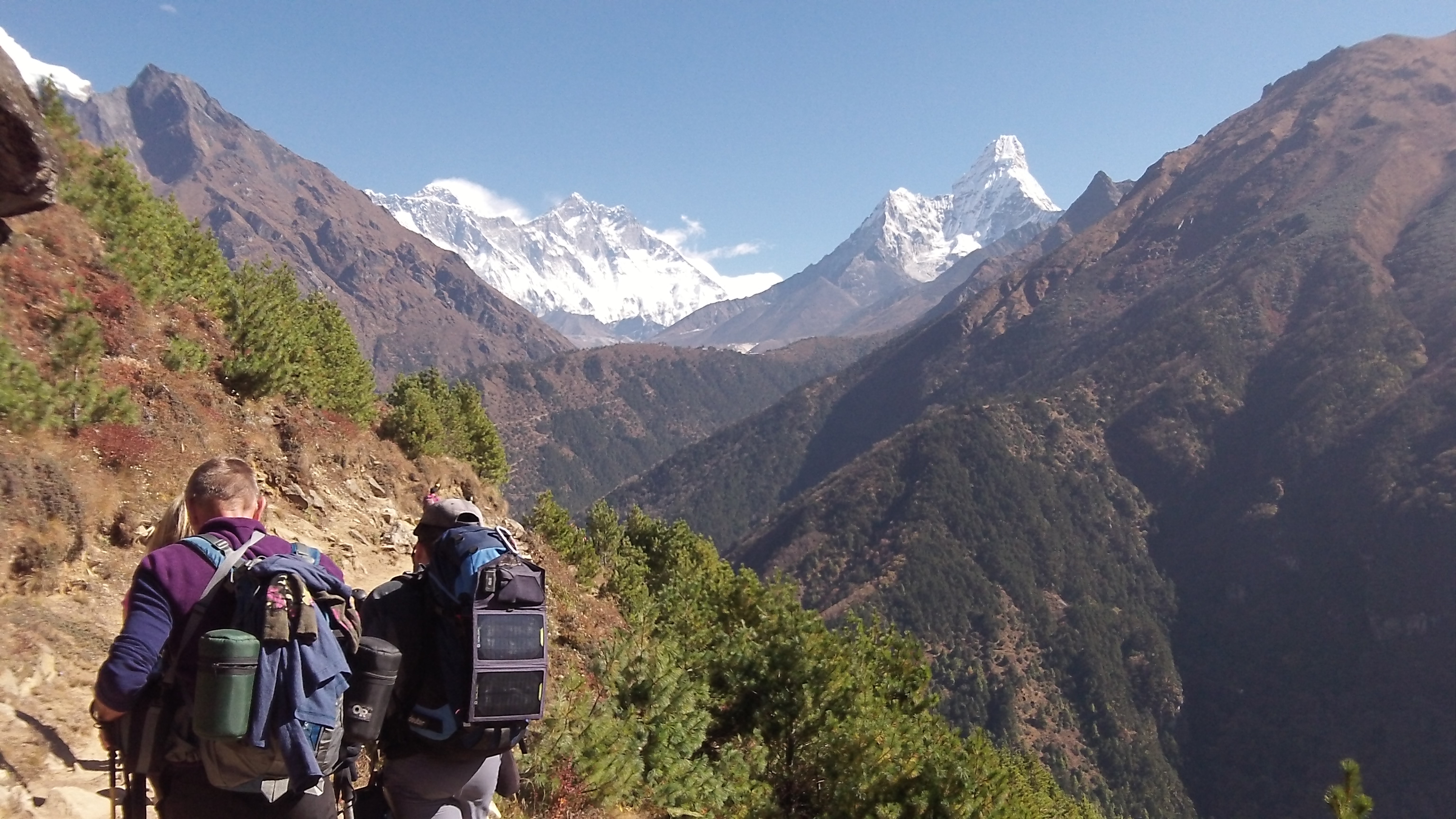
Why Choose Mountains in Mind?
- Excellent Sherpa conditions
- Supports the local community
- Small group sizes
- UK Guide
- Tailored itinerary
- Selective group dates
- Personal touch
- All inclusive price
- Deluxe accommodation
- Optional excursions
- GPS Trackers
-
On our Everest Base Camp trek you get to immerse yourself within this beautiful landscape, be surrounded by the world’s highest mountains and welcomed into the culture of this remote Sherpa region.
It’s a magical and breathtaking journey of discovery as you follow in the footsteps of the pioneers crossing exhilarating suspension bridges, dramatic cliff-edged pathways, meandering trails from the vegetated lush green foothills to rugged, glaciated landscapes.
There’s plenty of time to acclimatise as we slowly ascend giving you the opportunity to enjoy the truly spectacular views that will stay with you for a lifetime. We start on the main Everest tourist trail with mesmerising trains of yaks, donkeys and trekkers all vying for space as the uneven rocky paths wind their way up through remote villages. We branch away from the Khumbu and trek into the quieter Gokyo Valley where you can savour the sanctity and calmness as you reach the vibrant Gokyo lakes.
You won’t be dissappointed, this trek really does leave you speechless with awe-inspiring views that can bring a tear to anyone’s eyes.
-
- Saturday 3rd November 2018 – £3495
- Saturday 31st October 2020 – £3595
- Other dates available. Contact us for details.
-
- International flights
- Internal flights to Lukla
- All meals during the trek
- Welcome meal in Kathmandu
- Deluxe accommodation in Kathmandu
- Half-day sightseeing tour in Kathmandu
- A fully supported Sherpa team with Nepali Sirdar
- Porters to carry your baggage
- Traditional Nepali lodge accommodation
- Satellite phone
- Medical support
- Transfers to/from Kathmandu airport
- UK Expedition Leader
- All national park fees
- Online support and advice with your preparation
- Training plan (if required)
- Option to attend training weekend in the UK (at an additional cost)
- Plus memories and friends to last a lifetime !!!
-
- Personal Insurance
- IMPORTANT. Confirm with your insurance provider that your policy covers you for trekking to 6,000m and includes emergency helicopter evacuation to Kathmandu.
- Visa (obtainable at Kathmandu airport)
- Meals in Kathmandu (apart from the initial welcome meal)
- Beverages
- Porter tips
- Additional excursions
- Personal Insurance
-
Saturday 3rd November
Depart the UK
Board your flight from Heathrow to Kathmandu.Sunday 4th NovemberArrive Kathmandu
You will be greeted by our Nepalese representative on arrival at Kathmandu airport. If you’ve watched the Everest film the arrival in the airport is a true representation and the energy is amazing. You will then be whisked away to your hotel, where you’ll have time to freshen up before the trip briefing and evening meal.Accommodation: HotelMeals: B/DMonday 5th NovemberKathmandu SightseeingIncluded is an amazing sightseeing tour taking in some of the highlights of Kathmandu including the Boudhanath Temple. It’s a great time to experience the city and to soak up vibrancy and energy. The afternoon will be free time to fill up on last minute supplies or to visit the many gear and book shops in the Thamel district. In the evening you have the option to take evening meal in the hotel or Thamel district.Accommodation: HotelMeals: BTuesday 6th NovemberDepart for Lukla (2840m) and trek to Phakding (2610m)An early morning start to catch the plane to Lukla. This amazing flight is amongst the best in the world, you fly over Kathmandu into the Himalaya, where there will be ample time during the flight to take photos of the high mountains. On arrival at the Tenzing Hillary airport in Lukla, you will meet our Sherpa/Porter team. After introductions, you’ll depart the village and head towards the destination at Phakding. The scenery is amazing as you trek along paths shared with yaks, Sherpas and other trekkers.Accommodation: LodgeMeals: B/L/DDistance: 7 kmTime: 4 hoursWednesday 7th NovemberTrek to Namche Bazaar (3440m)The mornings are a little cool and you’ll probably start with your jackets on, but it’s not long before the high Himalayan sun heats up. The trail takes you through deep gorges and over metal swing bridges. The real climb starts at lunchtime as you head steeply up to Namche Bazaar, where there may be an opportunity to get the first glimpse of Mount Everest.Accommodation: LodgeMeals: B/L/DDistance: 10kmTime: 6 hoursThursday 8th NovemberAcclimatisation day in Namche Bazaar (3440m)During the morning, you take a short walk to the Everest View hotel to aid acclimatisation. The views of the highest mountain in the world are just spellbinding and the panorama of the Khumbu valley is unforgettable. There will be plenty of time in the afternoon to rest and go souvenir hunting in the Sherpa capital. The evening is often concluded with a game of pool in one of the many bars.Accommodation LodgeMeals: B/L/DFriday 9th NovemberNamche Bazaar to Khumjung (3780m)After a hearty breakfast, you start the day’s trek with a view of Mount Everest and Ama Dablam ahead. You’ll be high above the Khumbu valley, sharing the trail with yaks, Sherpas, and other trekkers. The main Khumbu trail, with it’s busy and hectic atmosphere is soon left behind as you head into the much quieter Gokyo Valley before the overnight stay in Phorste Thango.Accommodation: LodgeMeals: B/L/DDistance: 7 kmTime: 5 hoursSaturday 10th NovemberKhumjung to Dole (4050m)You leave Khunjung and rejoin the main trail for a short time before taking the more quieter trail again into the Gokyo valley. You’ll pass through lush valleys with rhododendron forests and see the Dudh Koshi Nadi river before heading higher onto open ground for the short walk to Dole.Accommodation: LodgeMeals: B/L/DDistance: 4 kmTime: 3 hoursSunday 11th NovemberDole to Machermo (4470m)You are now above the Dubh Koshi Nadi river. The Himalayan peaks of Phuletate(5597m) and Glyeng Kyaba Kharka(5195m) watch over you as the trail heads towards Machermo. The air is thinner now and you’ll move at a slow, comfortable pace, providing an ideal opportunity to take in the majestic environment. When you arrive in Machermo the rest of the day is yours to relax. In the afternoon there will be the opportunity to visit the Porter rescue centre for a presentation on the great work this charity carries out for the Sherpas in the region.Accommodation: LodgeMeals: B/L/DDistance: 5kmTime: 3 hoursMonday 12th NovemberRest day in MachermoToday you can take an optional, short acclimatisation walk above Machermo, where there will be an opportunity to view Everest. The rest of the day is time to relax and enjoy the solitude of the mountains.Accommodation: LodgeMeals: B/L/DTuesday 13th NovemberMachermo to Gokyo (4790m)You may wake to a dusting of snow, which not uncommon at this altitude. The morning sun starts to light up the high mountain of Kyajo Ri (6186m) behind the guest house, and in no time warms the day. The trek takes us higher into the remote Himalayan mountains and there will be a brief opportunity to see Mount Everest again behind Arakam Tse (6423m). As you head towards the mountain settlement of Gokyo, you’ll pass the first of the holy Gokyo lakes, Taujung Tsho and as then turn the corner you’ll get a glimpse of Cho Oyu (8201m), the world’s 7th highest mountain.Accommodation: LodgeMeals: B/L/DDistance: 7kmTime: 4 hoursWednesday 14th NovemberGokyo Ri (5,357m), back to Gokyo (4790m) to Dragnak (4700m)You will rise before dawn to trek to the summit of Gokyo Ri, which will be our first Himalayan summit. Here you can witness a truly memorable sunrise over the high mountain tops, which includes Mount Everest, Lhoste, Nupste and Manasalu. You’ll descend back to the guest house, where you will be rewarded with breakfast and rest until you depart for the crossing of the Ngozuma Glacier, the longest glacier in the Himalaya at 12km. You then continue the trek to the overnight accommodation in the small hamlet of Dragnak.Accommodation: LodgeMeals: B/L/DDistance: 8kmTime: 7 hoursThursday 15th NovemberDragnak via Cho La Pass (5420m) to Dzonglha (4830m)An early morning start again as this is the longest day of the trek. After breakfast, you’ll head up towards the Cho La Pass, crossing frozen streams you’ll scramble up towards the pass, where you will be rewarded with amazing far reaching views. As you trek over the pass there is time to have your packed lunch before descending over the Glacier and down through moraine to the overnight stay in the small settlement of Dzonglha.Accommodation: LodgeMeals: B/L/DDistance: 10kmTime: 7 hoursFriday 16th NovemberDzonglha to Lobuche (4910m)Today’s trek leads you back into the main Khumbu Valley. The route takes you below the base camp for Lobuche East (6090m), which is often used as an acclimatisation climb by Everest mountaineers. As you enter the Khumbu Valley there are fantastic views towards Ama Dablam (6814m), which was last seen before entering the Gokyo Valley. Lobuche is a bustling small settlement, which is frequented by trekkers and mountaineers alike and is where you stay overnight.Accommodation: LodgeMeals: B/L/DDistance: 7kmTime: 4 hoursSaturday 17th NovemberLobuche to Everest Base Camp (5364m) via Gorak Shep (5140m)You trek towards Everest Base Camp on the side of the Khumbu Glacier moraine walls. The moraines were created by the glaciers as it pushed the rock to its side as it made its way down the valley. The trail will have a busier feel to what you have been used to, as it is now shared with mountaineers and trekkers from all over the world. You’ll briefly check into a tea house and take lunch before heading to Everest Base Camp in the afternoon. You then head back to the accommodation for a well earned evening meal and rest.Accommodation: LodgeMeals: B/L/DDistance: 7kmTime: 5 hoursSunday 18th NovemberKalar Pathar (5550m) to catch the sunrise over Everest (8848m) Dingboche (4410m)The summit of Kalar Pathar is a wonderful place to witness an unforgettable sunrise over Mount Everest, from here you can clearly see the white band of Limestone rock underneath the Summit of Everest. This sedimentary rock was formed at the bottom of a warm ocean and has risen as it was forced upwards by the continental plates. Mount Everest is over 5 miles high and is still rising at an average of 0.1 inches per year! After a brief rest, you will descend back to the accommodation for breakfast before trekking to the next overnight stay in Dingboche.Accommodation: LodgeMeals: B/L/DDistance: 16kmTime: 8 hoursMonday 19th NovemberDingboche to Tengboche (3860m)You will continue to descend along the Khumbu Valley passing under the flanks of Ama Dablam and the glaciers of Churo & Duwo. The air heavier is now and with each step, you will become stronger. As you pass through villages with prayer wheels, you’ll be able to turn them clockwise as you pass. When you arrive at Tengboche there may be the opportunity to visit the monastery, where you can see Buddhist Monks in prayer.Accommodation: LodgeMeals: B/L/DDistance: 12kmTime: 6 hoursTuesday 20th NovemberTengboche to Monjo (2835m)After saying goodbye to Tengboche you pass a selection of Stupas on the way back to Namche Bazaar. The valley now has more vegetation and the sound of the waterfalls fill the air. You still need to keep an eye open for the many yak trains heading up and down the valley, along with oncoming trekkers who are following the Khumbu heading towards Everest Base Camp. The overnight stay is in the village of Monjo which you passed through at the begging of the trek.Accommodation: LodgeMeals: B/L/DDistance: 11kmTime: 5 hoursWednesday 21st NovemberMonjo to Lukla (2840m)After a wonderful evening in Monjo, you bid a fond farewell and descend back towards Lukla. The vegetation is a stark contrast to the high mountain environment you have experienced for almost two weeks. What amazing memories you will have as you head back towards Lukla for the last night in the Himalaya. After checking into the accommodation you are free to sample some of the local hostelries, celebrating the last night surrounded by the mountains.Accommodation: LodgeMeals: B/L/DDistance: 13kmTime: 5 hoursThursday 22nd NovemberLukla – Fly back to KathmanduStart with an early rise to catch the flight back to Kathmandu. Although, sometimes the flight may be delayed due low-lying cloud or fog so you may have to wait a while until it clears. You will say a tearful farewell to the Sherpa team who have been with you for over two weeks. Following the flight back to Kathmandu you will be transferred back to the hotel where you will be able to take a well-earned shower and relax. After being suitably refreshed you will be whisked away to a celebratory meal at one of the many eateries in the Thamel district.Accommodation: HotelMeals: BThis is a contingency day in case bad weather affects the flight from Lukla or is an additional day for sightseeing or souvenir hunting.If all goes to plan, this day is an ideal opportunity to visit the Thamel district or one of the many sights of Kathmandu. An optional excursion can be arranged or you may want to experience Kathmandu under your own steam. The evening meal isn’t included on this day as trekkers often like to do their own thing, that being said we can arrange another group meal if you prefer.Accommodation: HotelMeals: BFly back to the UKYou will sadly depart Kathmandu, with memories that will last a lifetime.There’s a saying ”your first time in Nepal will not be your last time!” Depending on the flight schedules you may arrive back in the UK during the evening.Meals: B & all in-flight mealsArrive back in the UKYou may arrive in the UK Saturday evening or Sunday morning. Flights will be confirmed 4-6 months before your departure date.Please Note: Whilst every effort is made to keep to the above schedule, the weather conditions, health and acclimatisation of team members could mean slight amendments may have to be made to the itinerary at very short notice. -
Saturday 31st October
Depart the UK
Board your flight from Heathrow.Sunday 1st NovemberArrive Kathmandu
You will be greeted by our Nepalese representative on arrival at Kathmandu airport and transferred to our hotel where you’ll have time to freshen up before the trip briefing and evening meal in the Thamel district.Accommodation: HotelMeals: DMonday 2nd NovemberKathmandu SightseeingIncluded is an amazing sightseeing tour taking in some of the highlights of Kathmandu including the Boudhanath Temple. The afternoon will be free. In the evening you have the option to take evening meal in the hotel or Thamel district.Accommodation: HotelMeals: BTuesday 3rd NovemberDepart for Lukla (2840m) and trek to Phakding (2610m)Depart Kathmandu for a flight to Lukla. On arrival at the Tenzing Hillary airport in Lukla, you will meet our Sherpa/Porter team and trek to our overnight destination at Phakding.Accommodation: LodgeMeals: B/L/DDistance: 7 kmTime: 4 hoursWednesday 4th NovemberTrek to Namche Bazaar (3440m)Today the trail takes you through deep gorges and over a number of metal suspension bridges. The trek climbs steeply after lunch as you ascend up to Namche Bazaar, where there may be an opportunity to get the first glimpse of Mount Everest.Accommodation: LodgeMeals: B/L/DDistance: 10kmTime: 6 hoursThursday 5th NovemberAcclimatisation day in Namche Bazaar (3440m)During the morning, you take a short acclimatisation walk to the Everest View hotel. There will be plenty of time in the afternoon to rest and go souvenir hunting in the Sherpa capital.Accommodation: LodgeMeals: B/L/DFriday 6th NovemberNamche Bazaar to Khumjung (3780m)You start the day’s trek with a view of Mount Everest and Ama Dablam ahead. The main Khumbu trail with it’s busy and hectic atmosphere is soon left behind as you head into the much quieter Gokyo Valley before the overnight stay in Phorste Thango.Accommodation: LodgeMeals: B/L/DDistance : 7 kmTime: 5 hoursSaturday 7th NovemberKhumjung to Dole (4050m)You leave Khumjung and rejoin the main trail for a short time before taking the more quieter trail again into the Gokyo valley. You’ll pass through lush valleys with rhododendron forests and see the Dudh Koshi Nadi river before heading higher onto open ground for the short walk to Dole.Accommodation: LodgeMeals: B/L/DDistance: 4 kmTime: 3 hoursSunday 8th NovemberDole to Machermo (4470m)You are now high above the Dubh Koshi Nadi river. When you arrive in Machermo the rest of the day is yours to relax. In the afternoon there will be the opportunity to visit the Porter rescue centre for a presentation on the great work this charity carries out for the Sherpas in the region.Accommodation: LodgeMeals: B/L/DDistance: 5kmTime: 3 hoursMonday 9th NovemberRest day in MachermoToday you can take an optional, short acclimatisation walk above Machermo, where there will be an opportunity to view Everest. The rest of the day is time to relax and enjoy the solitude of the mountains.Accommodation: LodgeMeals: B/L/DTuesday 10th NovemberMachermo to Gokyo (4790m)The trek takes us higher into the remote Himalayan mountains and there will be a brief opportunity to see Mount Everest again behind Arakam Tse (6423m). As you head towards the mountain settlement of Gokyo, you’ll pass the first of the holy Gokyo lakes, Taujung Tsho and as then turn the corner you’ll get a glimpse of Cho Oyu (8201m), the world’s 7th highest mountain.Accommodation: LodgeMeals: B/L/DDistance: 7kmTime: 4 hoursWednesday 11th NovemberGokyo Ri (5,357m), back to Gokyo (4790m) to Dragnak (4700m)You’ll trek to the summit of Gokyo Ri, which will be our first Himalayan summit. Here you can witness a truly memorable sunrise over the high mountain tops. You’ll descend back to the guest house, where you will be rewarded with breakfast and rest until you depart for the crossing of the Ngozuma Glacier, the longest glacier in the Himalaya at 12km. You then continue the trek to the overnight accommodation in the small hamlet of Dragnak.Accommodation: LodgeMeals: B/L/DDistance: 8kmTime: 7 hoursThursday 12th NovemberDragnak via Cho La Pass (5420m) to Dzonglha (4830m)An early morning start again as this is the longest day of the trek. After breakfast, you’ll head up towards the Cho La Pass. As you trek over the pass there is time to have your packed lunch before descending over the Glacier and down through the moraine to the overnight stay in the small settlement of Dzonglha.Accommodation: LodgeMeals: B/L/DDistance: 10kmTime: 7 hoursFriday 13th NovemberDzonglha to Lobuche (4910m)Today’s trek leads back into the main Khumbu Valley. As you enter the Khumbu Valley there are fantastic views towards Ama Dablam (6814m), which was last seen before entering the Gokyo Valley. Lobuche is a bustling small settlement, which is frequented by trekkers and mountaineers alike and is where you stay overnight.Accommodation: LodgeMeals: B/L/DDistance: 7kmTime: 4 hoursSaturday 14th NovemberLobuche to Everest Base Camp (5364m) via Gorak Shep (5140m)You trek towards Everest Base Camp on the side of the Khumbu glacial moraine walls. You’ll briefly check into a tea house at Gorek Shep and take lunch before heading to Everest Base Camp in the afternoon. You then head back to Gorek Shep for a well earned evening meal and rest.Accommodation: LodgeMeals: B/L/DDistance: 7kmTime: 5 hoursSunday 15th NovemberKalar Pathar (5550m) to catch the sunrise over Everest (8848m) Dingboche (4410m)You’ll rise earlier to ascend the summit of Kalar Pathar to witness an unforgettable sunrise over Mount Everest. After a brief rest, you will descend back to Gorek Shep for breakfast before trekking to the next overnight stay in Dingboche.Accommodation: LodgeMeals: B/L/DDistance: 16kmTime: 8 hoursMonday 16th NovemberDingboche to Tengboche (3860m)You will continue to descend along the Khumbu Valley passing under the flanks of Ama Dablam and the glaciers of Churo & Duwo. When you arrive at Tengboche there may be the opportunity to visit the monastery, where you can see Buddhist Monks in prayer.Accommodation: LodgeMeals: B/L/DDistance: 12kmTime: 6 hoursTuesday 17th NovemberTengboche to Monjo (2835m)After saying goodbye to Tengboche you pass a selection of Stupas on the way back to Namche Bazaar. The overnight stay is in the village of Monjo, which you passed through at the beginning of the trek.Accommodation: LodgeMeals: B/L/DDistance: 11kmTime: 5 hoursWednesday 18th NovemberMonjo to Lukla (2840m)After a wonderful evening in Monjo, you bid a fond farewell and descend back towards Lukla. After checking into the accommodation you are free to sample some of the local hostelries, celebrating the last night surrounded by the mountains.Accommodation: LodgeMeals: B/L/DDistance: 13kmTime: 5 hoursThursday 19th NovemberLukla – Fly back to KathmanduWe rise early to catch one of the first flights back to Kathmandu. Sometimes the flight may be delayed due low-lying cloud or fog so you may have to wait a while until it clears. Following the flight back to Kathmandu you will be transferred back to the hotel where you will be able to take a well-earned shower and relax. After being suitably refreshed you will be whisked away to a celebratory meal at one of the many eateries in the Thamel district.Accommodation: HotelMeals: BThis is a contingency day in case bad weather affects the flight from Lukla or is an additional day for sightseeing or souvenir hunting.If all goes to plan, this day is an ideal opportunity to visit the Thamel district or one of the many sights of Kathmandu. An optional excursion can be arranged or you may want to experience Kathmandu under your own steam.Accommodation: HotelMeals: BFly back to the UKYou will sadly depart Kathmandu, with memories that will last a lifetime. There’s a saying ”your first time in Nepal will not be your last time!” Depending on the flight schedules you may arrive back in the UK during the evening.Meals: B & all in-flight mealsArrive back in the UKYou may arrive in the UK Saturday evening or Sunday morning. Flights will be confirmed 4-6 months before your departure date.Please Note: Whilst every effort is made to keep to the above schedule, the weather conditions, health and acclimatisation of team members could mean slight amendments may have to be made to the itinerary at very short notice. -
This trek is classified as tough due to the number of continuous days trekking, the steepness of the paths, the possible effects of altitude and the mountainous terrain that it encounters.
Our treks will be going at a steady to pace to aid with acclimatisation and so that you have an enjoyable experience. We want you to take in the views whilst you are trekking!
To assist you in having an enjoyable experience, it helps if you have a good base-level of fitness. If you have any concerns or worries over your fitness levels, we are happy to talk this through with you. We can support you with your training by discussing a training plan with you. We also offer a training weekend so that you can experience similar terrain to what you’ll experience on the trek.
-
Chitwan National Park Safari
We can provide a one, two or three day safari in the Chitwan National Park. An amazing destination and one of the best areas in Asia for viewing wildlife, such as, leopards, elephants, a variety of monkeys and rhinos.
Pokhara
Visit Nepal’s second city, Pokhara. In contrast to the vibrant and bustling Kathmandu, Pokhara is on the shores of Lake Phewa, has magnificent views over to the Annapurna Range is much more sedate. It’s a short 30 minute flight from Kathmandu and there’s plenty to see and do when you get there. Enjoy a relaxing spa, take a boat trip on Lake Phewa, walk up to the World Peace Stupa or for the thrill seekers take a parapent ride from Mount Sarangkot.
-
- How fit do I need to be?
This is a tough trek due to the duration and the time spent at altitude. Like every physical and strenuous activity, it helps to have a good base level of fitness. You don’t need to be a marathon runner though. A general rule of thumb is if you can walk on average for 6-8 hours a day for 2 consecutive days back to back and have walked in a mountainous environment beforehand so are familiar with walking up a hill and the terrain, you will be more than ready. - What is the temperature like?
You will experience a range of temperatures from 20+ degrees in Kathmandu to -10 degrees overnight during the trek. When we are over 4,000m in altitude, temperatures are similar to that of walking in the mountains during the autumn or fall. The mornings are often cold with frost and sometimes there is snow on the ground but as the sun rises so do the temperatures. - How technical is the climb?
Will we need ropes? The main routes require no technical mountaineering skills but there are some steep sections along the trail. Crossing the Cho La Pass will require basic scrambling skills as we ascend over scree. The descent will require sure footing and your guides will be on hand to help if required. - Do I require a visa to enter Nepal?
Yes. These can be obtained from the Nepal embassy in your country. Entry visas can be obtained on arrival at Kathmandu airport at a cost of $40 for 30 days. - What vaccinations do I require?
We always advise you to contact a travel clinic, GP or Physician to discuss your travel plans. You will possibly require the following although, please be aware that some of the advised vaccinations will need to be taken some weeks or months prior to your departure date to be effective. You can check the up-to-date recommended vaccinations on the NHS website.
Please note that for Yellow Fever this needs to be no less than 10 days before departure and you will require a Yellow Fever card. - Passport.
The Nepal immigration requires that your passport is valid for 6 months prior to the date of your travel departure. For more information please click here - What food do I need to bring with me?
All food is supplied on the mountain and you’ll be amazed at the quantity you’ll receive during the trek. The staple diet of trekking in the Himalaya is Dal Bhat, a local dish comprising a mixture of lentils, vegetables and rice with naan bread. It is advisable to bring some home comforts with you. Snacks you can eat during the day are also a great idea (nuts, seeds, raisins). If you’d like to spice up your meal a bottle of Tabasco sauce is very popular. - What personal kit and clothes should I bring with me?
We have compiled a very concise equipment list, which we encourage you to review. You’ll need a comfortable and worn in pair of walking boots, a waterproof jacket and over trousers. At first, you may think why should I need waterproofs but it can rain during the trek and the extra layers, especially in the early morning starts, will help you to stay warm and keep out any wind. Please note ski jackets and trousers/salopettes are not typically waterproof and if wet, can take a long time to dry out so are not recommended. There will be opportunities to wash some of your personal clothes during the trek although it’s back to basics with warm water and a bowl 🙂 - Will I have to carry all my gear on the mountain?
The simple answer is no. You’ll have a Sherpa (Porter), who will carry the majority of your gear. All you’ll be required to carry is what you need during the day. - What will I be carrying during the day?
You will be required to carry a rucksack of between 25 – 35 litres in size. In this, you’ll have 2 litres of water, your food for the day, a warm top, personal items and medical pack, sun cream, hat, gloves, camera, waterproof jacket and trousers. - What size bags should I bring?
On the mountain, your kit and gear will be carried by the Sherpas. For their comfort and safety, we ask that you bring a 70-90 litre duffle style bag (no frames/suitcases). The weight allowed to be carried by the Sherpas is restricted. For both your personal backpack and duffle bag it is recommended that you purchase waterproof liner bags. - What is the weight limit for my bags?
On the international flight, it’s normally 30kg.
For the internal flight, it’s 15kg for both your hand luggage and hold baggage combined. - Can I leave a spare set of clothes at the hotel?
There is a facility to store your unwanted gear that you won’t need on the trek at the hotel. Although it’s advised that you take all of your valuables with you during the trek. - What will I need in my first aid kit?
The most common problems adventures experience on a trek of this kind are blisters, stomach upsets and headaches. Please preview the detailed personal first aid kit in the equipment list for recommended items to carry. - What if I take prescribed medication?
Please contact your doctor or a physician to confirm your medication is ok to be taken at altitude. We recommend that you pack accordingly for the number of days you are in Nepal. Carry your personal medication in your hand luggage and bring an additional quantity just in case you lose it. If you have any medical conditions, please notify us on the booking form and again on arrival in Nepal. If your conditions change, please contact us before departure. - Will I get altitude sickness?
This is the most commonly asked question for anybody booking on this trip, and quite rightly so. Everybody at some stage during the trip will experience some form of altitude sickness. Although very uncomfortable at the time, it’s our bodies way of adjusting to the change in altitude and the lack of oxygen in the atmosphere. The symptoms range from headaches to feeling nauseous and we can take simple medication to overcome these feelings. After a period of time, hopefully, these symptoms should pass as you acclimatise. The advised method of aiding acclimatisation is to walk very, very slowly, drink 3-4 liters of water each day to ensure that you keep hydrated during the trek, eating little and often even if you don’t feel like it and to eat lots at meal times. - Can I take Diamox?
The use of Diamox (Acetazolamide) has always been a topic of much discussion. The drug was designed for the treatment of a number conditions; glaucoma, sleep apnea, epileptic seizures, to name but a few. It was never designed for helping with the acclimatisation process. That being said, there are many reported accounts of the drug aiding with acclimatisation and it can now be prescribed from your GP or Physician. There is a proven method of administration and we can discuss this with you on arrival in Nepal. All we ask is you let us know you are intending to self-medicate as this will help with the mountain medical care. - What is the hotel like?
We have chosen a good quality deluxe hotel in Kathmandu, which is in the heart of the main Thamel District. - What is the currency in Nepal and what money should I bring?
US Dollars are accepted in most places, such as restaurants, hotels and bars. Rupees are the main currency in Nepal and there are bureaux de change facilities a short walk from the hotel. There are also a number of ATMs around the city where you can withdraw currency although these can be a little temperamental. Nepal rupees are not available to buy outside of Nepal. - How much money do I take with me during the trek?
All the meals are included in the trip but it is advisable to take some money with you for extra meals, snacks and souvenirs. Is difficult to say how much but $200-$300 should be enough. - Are credit cards accepted?
Cards are widely accepted in the restaurants, cafes and some shops of Kathmandu but are not widely accepted outside of the city. It’s advisable to notify your bank before departure. There is a number of ATMs around the city where you can withdraw cash. - What is the required amount that I should tip?
In many countries around the world, tipping is part of the culture. Tipping in Nepal can boost the earnings for the local Sherpa people. The suggested tip amount will be in the region of $200 at the end of the week and you’ll see why we tip. - How safe are my travel documents?
Keep your travel documents with you in your day sack on the trek. We advise that you take 2 or 3 photocopies as you’ll need your passport on registering with the national park. It may be an idea to store electronic copies on Google drive or Dropbox too. - Is the Water on the mountain fit to drink?
We will take an additional porter on the trek to carry fuel and a stove to boil large quantities of water. The water is boiled by the porters and is fit to drink. If you prefer, you can bring water purification tablets too. To remove the chlorine taste that the tablets leave behind, it is advisable to bring some powdered energy drink mix. Bottled water is available during the trek but can be costly and we don’t recommend you purchasing it due the amount of plastic waste. - What toiletries should I bring on the trek?
The most common illness on any expedition overseas (and the UK) is sickness and diarrhoea. This you may think is from the drinking the water or food but in reality is usually from poor personal hygiene (dirty hands/finger nails). We suggest bringing a small nail brush, baby wipes, sanitising gel, toilet paper and any other basic products with you on the trek as these are not readily available. - Are there showers during the trek?
There are showers in some of the lodges and tea houses but these are limited. Water is heated either by solar energy or paraffin-fueled stoves. There will be access to warm water and a bowl to take care of your personal hygiene. - Are transfers from Kathmandu airport included in the trip and how long will the transfer take?
You will be met outside arrivals at Kathmandu airport by a representative from Mountains in Mind, who will be holding a board with the company’s logo. You will then be taken straight to the hotel. The journey time is approximately 45 minutes. - What type of electric plug adapters do I need?
An international travel TYPE-D adapter will be required.
- How fit do I need to be?
-

